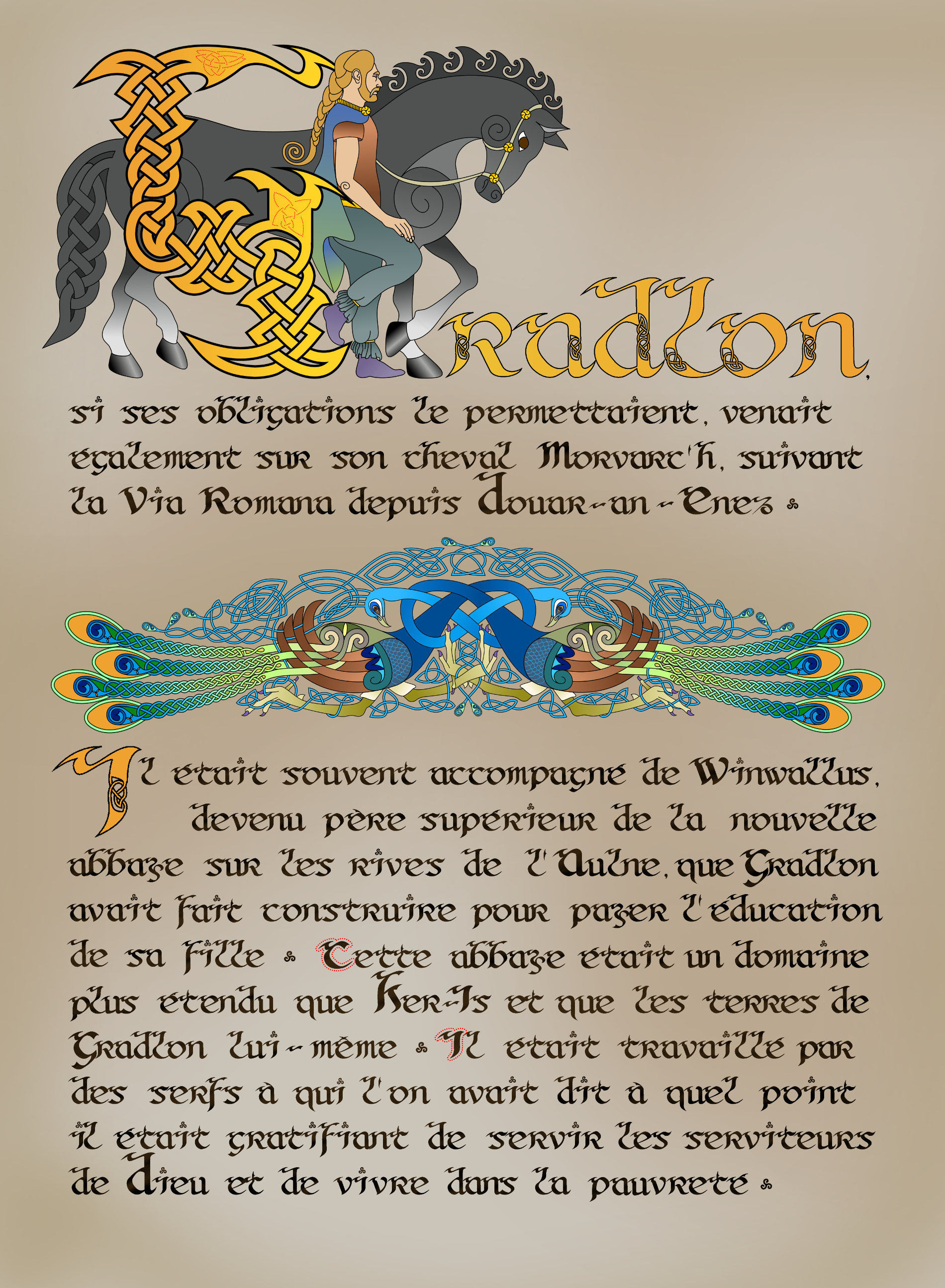fol. 10v
Gradlon, si ses obligations le permettaient, venait également sur son cheval Morvarc'h, suivant la Via Romana(1) depuis Douar-an-Enez(2).
Il était souvent accompagné de Winwallus, devenu père supérieur de la nouvelle abbaye sur les rives de l’Aulne(3) que Gradlon avait fait construire pour payer l’éducation de sa fille.
Cette abbaye était un domaine plus étendu que Ker-is et que les terres de Gradlon lui-même.
Il était travaillé par des serfs à qui l'on avait dit à quel point il était gratifiant de servir les serviteurs de Dieu et de vivre dans la pauvreté.
(1) La route départementale D7, qui relie Douarnenez à la pointe du Van, est toujours appelée la "voie romaine".
(2) Il est clair qu'une ville existait déjà sur le site de l'actuel Douarnenez à l'époque romaine. Cependant, son nom a été perdu.
Le plus ancien nom connu pour Douarnenez est "Leones" et il apparaît sur une carte du géographe et explorateur arabe Charif Al Idrissi au XIIe siècle.
Leones est probablement une distorsion du latin "Legionense", une ville où campait une légion romaine.
Le nom breton "Douar an Enez" n'apparaît officiellement qu'à la fin du XVIe siècle et signifie "la terre de l'île", qui fait référence à l'île de Tristan. Lors de fouilles au XIXe siècle, de nombreux objets gallo-romains y sont trouvés.
Dans mon imaginaire, c'est là que Gradlon s'était installé en tant que préfet gallo-romain.
(3) L'abbaye de Landévennec:
"Lann" signifie "sanctuaire" ; "Tevenneg" est basé sur To-Winnoc, forme de "Guénolé", en vieux breton "Winwaloe".
Landévennec est donc le "sanctuaire de Guénolé".
"Quant au fief abbatial de Landévennec, qui fermait le presqu'île du côté de l'est, il remontait, non au roi Gradlon comme les moines du XIe siècle s'avisérent de le dire dans leurs chartes apocryphes, mais au fondateur même de l'abbaye, saint Gwennolé, qui l'avait formé dès les premiers temps de l'émigration bretonne (Ve-VIe siècles) en s'en appropriant le sol par le défrichement et la culture. " (source: Arthur Le Moyne de La Borderie, "Histoire de Bretagne", tome 3, 1898-1914)
Des fouilles ont confirmé l'existence, fin du cinquième, début du sixième siècle, d'un petit oratoire près d'un établissement gallo-romain, entouré de tombes, dont peut-être celle de Guénolé.
fol.10v
Gradlon, if his obligations permitted, also came to Ker-Is on his horse Morvarc'h, following the Via Romana(1) from Douar-an-Enez(2).
He was often accompanied by Winwallus, who was now the father superior of the new abbey on the banks of the Aulne(3), which Gradlon had built to pay for his daughter's education.
This abbey was on an area larger than Ker-is and the lands of Gradlon itself.
It was worked by serfs who had been told how rewarding it was to serve the servants of God and live in poverty.
(1) The D7 departmental road, which links Douarnenez to the Pointe du Van, is still called the "Roman road".
(2) It is clear that in Roman times, a city already existed on the site of present-day Douarnenez . However, it's name has been lost.
The oldest known name for Douarnenez is "Leones" and it appears on a map by the 12th century Arab geographer and explorer Charif Al Idrissi.
Leones is probably a distortion of the Latin "Legionense", a city where a Roman legion was encamped.
The Breton name "Douar an Enez" does not appear officially until the end of the 16th century and means "the land of the island", which refers to the island of Tristan. During excavations in the 19th century, many Gallo-Roman objects were found there.
In my imagination, this is where Gradlon had settled as a Gallo-Roman prefect.
(3) Landévennec abbey:
"Lann" means "sanctuary"; "Tevenneg" is based on To-Winnoc, form of "Guénolé", in old Breton "Winwaloe".
Landévennec is therefore the "sanctuary of Guénolé".
" As for the abbey fief of Landévennec, which closed the peninsula on the eastern side, it went back, not to King Gradlon as the monks of the eleventh century took it upon themselves to say in their apocryphal charters, but to the very founder of the abbey, Saint Gwennolé, who had formed it from the earliest days of Breton emigration on (5th-6th centuries), by appropriating the soil through clearing and cultivation. " (source: Arthur Le Moyne de La Borderie, "History of Brittany", volume 3, 1898-1914)
Excavations have confirmed the existence, at the end of the fifth, beginning of the sixth century, of a small oratory near a Gallo-Roman establishment, surrounded by tombs, including perhaps that of Guénolé.
Cliquez l'image pour une meilleure qualité.
Click on the picture for a better quality.

